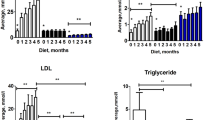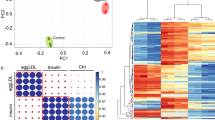Abstract
The observations that atherosclerosis often occurs in non-smokers without elevated levels of low-density lipoprotein cholesterol, and that most atherosclerosis loci so far identified in mice do not affect systemic risk factors associated with atherosclerosis1, suggest that as-yet-unidentified mechanisms must contribute to vascular disease. Arterial walls undergo regional disturbances of metabolism2 that include the uncoupling of respiration and oxidative phosphorylation, a process that occurs to some extent in all cells and may be characteristic of blood vessels being predisposed to the development of atherosclerosis3. To test the hypothesis that inefficient metabolism in blood vessels promotes vascular disease, we generated mice with doxycycline-inducible expression of uncoupling protein-1 (UCP1) in the artery wall. Here we show that UCP1 expression in aortic smooth muscle cells causes hypertension and increases dietary atherosclerosis without affecting cholesterol levels. UCP1 expression also increases superoxide production and decreases the availability of nitric oxide, evidence of oxidative stress. These results provide proof of principle that inefficient metabolism in blood vessels can cause vascular disease.
This is a preview of subscription content, access via your institution
Access options
Subscribe to this journal
Receive 51 print issues and online access
$199.00 per year
only $3.90 per issue
Buy this article
- Purchase on Springer Link
- Instant access to full article PDF
Prices may be subject to local taxes which are calculated during checkout




Similar content being viewed by others
References
Allayee, H., Gharalpour, A. & Lusis, A. J. Using mice to dissect genetic factors in atherosclerosis. Arterioscler. Thromb. Vasc. Biol. 23, 1501–1509 (2003)
Heuper, W. C. General reviews. Arch. Pathol. 38, 162–181 (1944)
Santerre, R. F., Nicolosi, R. J. & Smith, S. C. Respiratory control in preatherosclerotic susceptible and resistant pigeon aortas. Exp. Mol. Pathol. 20, 397–406 (1974)
Dröge, W. Free radicals in the physiological control of cell function. Physiol. Rev. 82, 47–95 (2002)
Nohl, H. Generation of superoxide radicals as byproduct of cellular respiration. Ann. Biol. Clin. (Paris) 52, 199–204 (1994)
Skulachev, V. P. Uncoupling: New approaches to an old problem of bioenergetics. Biochim. Biophys. Acta 1363, 100–124 (1998)
Echtay, K. S. et al. Superoxide activates mitochondrial uncoupling proteins. Nature 415, 96–99 (2002)
Nishikawa, T. et al. Normalizing mitochondrial superoxide production blocks three pathways of hyperglycaemic damage. Nature 404, 787–790 (2000)
Blanc, J. et al. Protective role of uncoupling protein 2 in atherosclerosis. Circulation 107, 388–390 (2003)
Pettersson, G. Effect of dinitrophenol and anoxia on isometric tension in rabbit colon smooth muscle. Acta Pharmacol. Toxicol. (Copenh.) 57, 184–189 (1985)
Moessler, H. et al. The SM 22 promoter directs tissue-specific expression in arterial but not in venous or visceral smooth muscle cells in transgenic mice. Development 122, 2415–2425 (1996)
Manning, M. W., Cassis, L. A. & Daugherty, A. Differential effects of doxycycline, a broad-spectrum matrix metalloproteinase inhibitor, on angiotensin II-induced atherosclerosis and abdominal aortic aneurysms. Arterioscler. Thromb. Vasc. Biol. 23, 483–488 (2003)
Heaton, J. M. The distribution of brown adipose tissue in the human. J. Anat. 112, 35–39 (1972)
Szekely, M., Kellermayer, M., Cholnoky, G. & Sumegi, I. Thermoregulatory heat production by periaortic brown adipose tissue in the non-cold-acclimatized rat. Experientia 26, 1314–1315 (1970)
Kanski, J., Behring, A., Pelling, J. & Schöneich, C. Proteomic identification of 3-nitrotyrosine-containing rat cardiac proteins: effect of biological aging. Am. J. Physiol. Heart Circ. Physiol. 288, H371–H381 (2005)
Su, B. et al. Redox regulation of vascular smooth muscle cell differentiation. Circ. Res. 89, 39–46 (2001)
Zai, A., Rudd, M. A., Scribner, A. W. & Loscalzo, J. Cell-surface protein disulfide isomerase catalyzes transnitrosation and regulates intracellular transfer of nitric oxide. J. Clin. Invest. 103, 393–399 (1999)
Tamarit, J., Cabiscol, E. & Ros, J. Identification of the major oxidatively damaged proteins in Escherichia coli cells exposed to oxidative stress. J. Biol. Chem. 273, 3027–3032 (1998)
Gardner, P. R. Aconitase: Sensitive target and measure of superoxide. Methods Enzymol. 349, 9–23 (2002)
Watts, H. in Evolution of the Atherosclerotic Plaque (ed. Jones, R. J.) 117 (Univ. Chicago, Chicago, 1963)
Chen, J. et al. Hypertension does not account for the accelerated atherosclerosis and development of aneurysms in male apolipoprotein E/endothelial nitric oxide synthase double knockout mice. Circulation 104, 2391–2394 (2001)
Knowles, J. W. et al. Enhanced atherosclerosis and kidney dysfunction in eNOS-/- apoE-/- mice are ameliorated by enalapril treatment. J. Clin. Invest. 105, 451–458 (2000)
Levin, M. et al. Mapping of ATP, glucose, glycogen and lactate concentrations within the arterial wall. Arterioscler. Thromb. Vasc. Biol. 25, 1801–1807 (2003)
Jennings, R. B., Kaltenbach, J. P. & Sommers, H. M. Mitochondrial metabolism in ischemic injury. Arch. Pathol. 84, 15–19 (1967)
Smith, E. B. The effects of age and of early atheromata on the intimal lipids in men. Biochem. J. 84, 49P (1962)
Smith, E. B. Lipids carried by Sf 0–12 lipoprotein in normal and hypercholesterolaemic serum. Lancet 2, 530–534 (1962)
Klein, P. D. & Johnson, R. M. Phosphorus metabolism in unsaturated fatty acid-deficient rats. J. Biol. Chem. 211, 103–110 (1954)
Hayashida, T. & Portman, O. W. Swelling of liver mitochondria from rats fed diets deficient in essential fatty acids. Proc. Soc. Exp. Biol. Med. 103, 656–659 (1960)
Cornwell, D. G. & Panganamala, R. V. Atherosclerosis: an intracellular deficiency in essential fatty acids. Prog. Lipid Res. 20, 365–376 (1981)
Sjodin, B., Hellsten Westing, Y. & Apple, F. S. Biochemical mechanisms for oxygen free radical formation during exercise. Sports Med. 10, 236–254 (1990)
Acknowledgements
This study was supported by grants from the National Institutes of Health, Clinical Nutrition Research Unit, Diabetes Research and Training Center, an American Diabetes Association Mentor-Based Postdoctoral Fellowship, and by institutional resources provided by Washington University and the Siteman Cancer Center to the Proteomics Center at Washington University.
Author information
Authors and Affiliations
Corresponding author
Ethics declarations
Competing interests
Reprints and permissions information is available at npg.nature.com/reprintsandpermissions. The authors declare no competing financial interests.
Supplementary information
Supplementary Figure S1
Body weight and serum chemistries in Dox-treated SM22-TRE UCP1 mice. (EPS 335 kb)
Supplementary Figure S2
Blood pressure as determined by telemetry in SM22-TRE UCP1 mice (panel a) and SM22-TRE UCP1 apoE-/- mice (panel b). (EPS 300 kb)
Supplementary Figure S3
Effects of UCP1 induction on atherosclerosis and serum cholesterol in chow-fed mice. (EPS 587 kb)
Supplementary Figure S4
Metabolic characterization and glucose tolerance in SM22-TRE UCP1 apoE-/- mice with Western diet feeding. (EPS 360 kb)
Supplementary Figure S5
UCP1 expression in extra-aortic arteries. (EPS 307 kb)
Supplementary Figure S6
Effect of tempol on tail cuff blood pressure in Dox-treated SM22-TRE UCP1 apoE-/- mice. (EPS 303 kb)
Supplementary Figure Legends S1-S6
This file contains legends for Supplementary Figures 1-6. (DOC 11 kb)
Supplementary Methodology
This file contains Supplementary Methodology. (DOC 8 kb)
Supplementary Notes
This file contains additional references. (DOC 12 kb)
Rights and permissions
About this article
Cite this article
Bernal-Mizrachi, C., Gates, A., Weng, S. et al. Vascular respiratory uncoupling increases blood pressure and atherosclerosis. Nature 435, 502–506 (2005). https://doi.org/10.1038/nature03527
Received:
Accepted:
Issue Date:
DOI: https://doi.org/10.1038/nature03527
This article is cited by
-
Bone marrow mesenchymal stem cellsderived exosomes stabilize atherosclerosis through inhibiting pyroptosis
BMC Cardiovascular Disorders (2023)
-
Mitochondrial Damage and Hypertension: Another Dark Side of Sodium Excess
Current Nutrition Reports (2023)
-
CR6-interacting factor 1 deficiency reduces endothelial nitric oxide synthase activity by inhibiting biosynthesis of tetrahydrobiopterin
Scientific Reports (2020)
-
Macrophage secretion of miR-106b-5p causes renin-dependent hypertension
Nature Communications (2020)
-
Functional interactions between complex I and complex II with nNOS in regulating cardiac mitochondrial activity in sham and hypertensive rat hearts
Pflügers Archiv - European Journal of Physiology (2020)
Comments
By submitting a comment you agree to abide by our Terms and Community Guidelines. If you find something abusive or that does not comply with our terms or guidelines please flag it as inappropriate.



